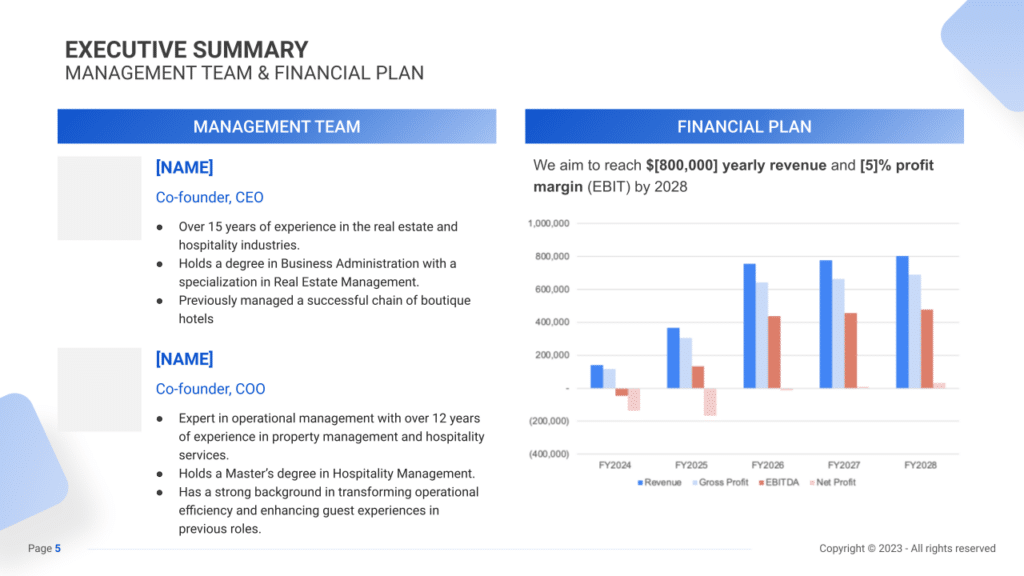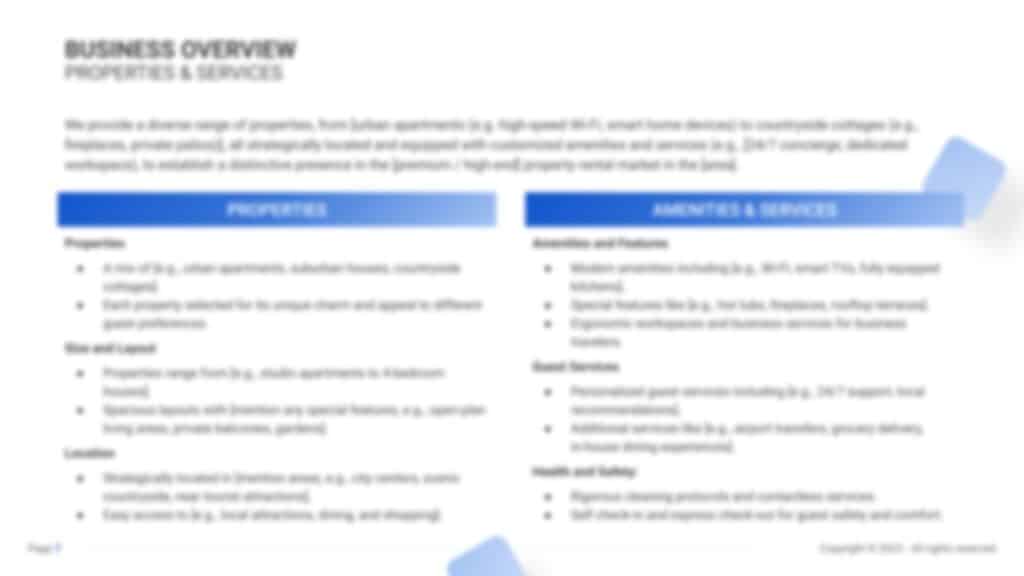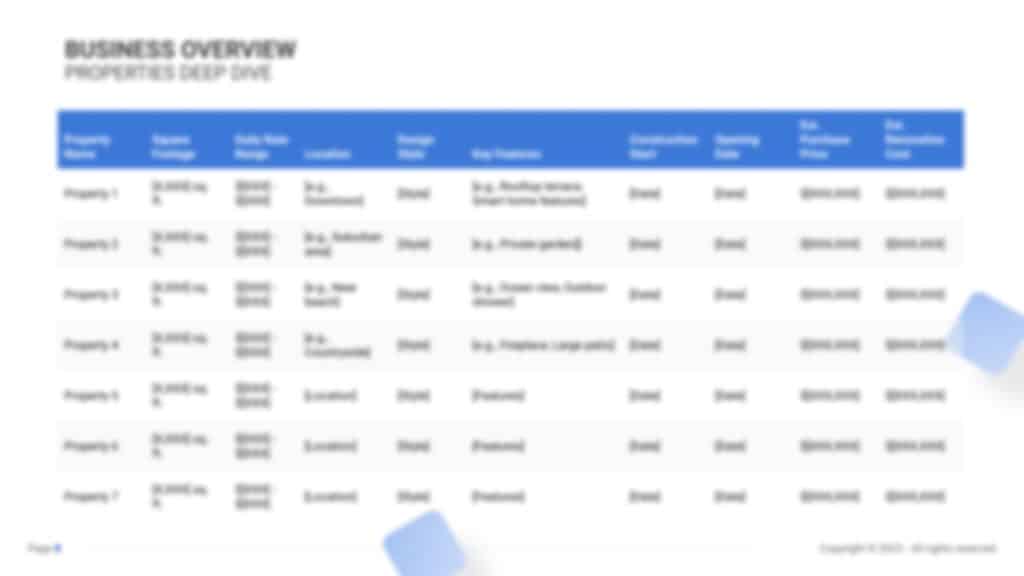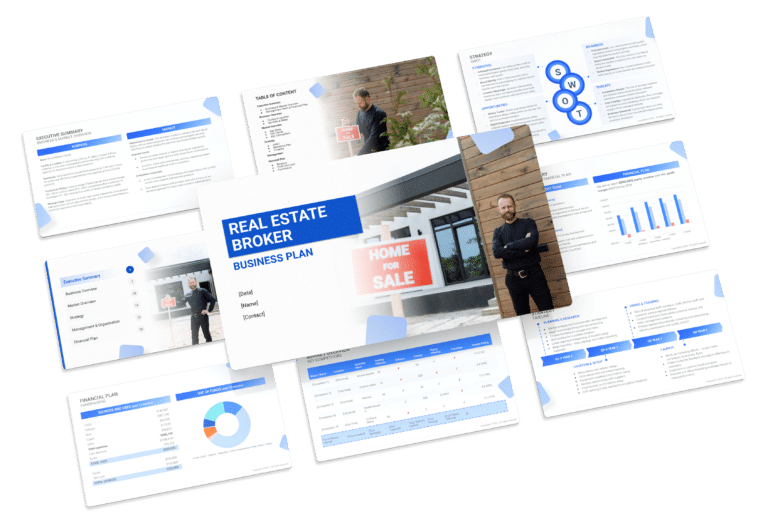Property Rental Business Plan Template & PDF Example

Creating a comprehensive business plan is crucial for launching and running a successful property rental business. This plan serves as your roadmap, detailing your vision, operational strategies, and financial plan. It helps establish your property rental business’s identity, navigate the competitive market, and secure funding for growth.
This article not only breaks down the critical components of a property rental business plan, but also provides an example of a business plan to help you craft your own.
Whether you’re an experienced entrepreneur or new to the real estate industry, this guide, complete with a business plan example, lays the groundwork for turning your property rental business concept into reality. Let’s dive in!
The Plan
Our property rental business plan is structured to cover all essential aspects needed for a comprehensive strategy. It outlines the rental operations, marketing strategy, market environment, competitors, management team, and financial forecasts.
- Executive Summary: Offers an overview of the property rental business’s concept, market analysis, management, and financial strategy.
- Business Overview: Provides detailed information on the property rental offerings and operational model:
- Properties, Amenities & Services: Describes the diverse range of properties, from urban apartments to countryside cottages, each equipped with customized amenities and services to cater to various guest preferences.
- Properties Deep Dive: Offers a detailed look into each property, including design style, location, key features, and financials related to purchase and renovation.
- Market Overview: Examines the short-term rental industry landscape, identifying competitors and how the business stands out:
- Key Stats: Shares industry size, growth trends, and relevant statistics for the short-term rental market.
- Key Trends: Highlights recent trends affecting the short-term rental sector, such as the rise of eco-friendly properties, technology integration, and the shift towards local experiences.
- Key Competitors: Analyzes main competitors and differentiates the business based on unique property offerings and guest experiences.
- Strategy: Outlines how the property rental business intends to achieve growth and attract guests:
- SWOT: Strengths, weaknesses, opportunities, and threats analysis.
- Marketing Plan: Strategies for marketing the properties to maximize occupancy and revenue.
- Timeline: Key milestones and objectives from property acquisition and planning through launch and operational optimization.
- Management: Information on who manages the property rental business and their roles.
- Financial Plan: Projects the business’s financial performance, including revenue, profits, and expected expenses, with a focus on achieving profitability and sustainable growth.

Executive Summary
The Executive Summary introduces your property rental business plan, providing a succinct overview of your rental operation and its offerings. It should detail your market positioning, the variety of properties you manage, their locations, sizes, and an overview of day-to-day management practices.
This section should also discuss how your property rental business will fit into the local real estate market, including the number of direct competitors in the area, identifying who they are, along with your business’s unique selling points that set it apart from these competitors.
Moreover, it’s important to include information about the management and co-founding team, detailing their roles and contributions to the business’s success. Additionally, a summary of your financial projections, including revenue and profits over the next five years, should be presented here to provide a clear picture of your property rental business’s financial plan.
Property Rental Business Plan Executive Summary Example


Business Overview
The business overview should define the key characteristics of your rental business, including your approach to property selection, design, furnishing, and the tailored guest experiences you offer. Highlighting what sets your properties apart in the competitive short-term rental market is key to attracting interest and investment.
Example:
“StayUnique Rentals,” a dynamic property rental business, has a portfolio of 7 unique properties, ranging from urban apartments to countryside cottages. Each property is meticulously designed and furnished to create a distinctive living experience. Beyond standard rentals, StayUnique offers personalized guest services like a 24/7 concierge, local experience packages, and tailored amenities, enhancing the overall guest experience.
Market Analysis
This section should analyze the short-term and vacation rental market’s size, growth trends, and competitive landscape. It positions your business within the industry and underscores its potential in meeting the growing demand for unique and flexible lodging options.
Example:
StayUnique Rentals enters a US market valued at $19 billion, with a 1.49% CAGR. The business differentiates itself amidst various competitors by offering properties that provide unique, localized experiences, catering to a trend where travelers increasingly value authenticity and personalized services over traditional hotel stays.
Management Team
Detailing the management team’s background and roles is essential. This part of the summary should emphasize their experience in real estate, hospitality, and operational management, highlighting their capability to lead the business to success.
Example:
The CEO of StayUnique, with 15 years of experience in real estate and hospitality, leads the business strategy and expansion. The COO, an expert in hospitality management, focuses on operational efficiency and guest experience, ensuring each property maintains high standards of service and guest satisfaction.
Financial Plan
Clearly outlining the financial goals and projections is crucial. This section should include revenue targets and profit margins, offering insight into the business’s financial health and growth prospects.
Example:
StayUnique Rentals aims to achieve $800,000 in yearly revenue with a 5% EBIT margin by 2028. Supported by a strategic approach to property management and marketing, coupled with exceptional guest experiences, the company is positioned for significant growth in the evolving short-term rental market.
Business Overview
For a Property Rental Business, the Business Overview section can be effectively divided into 2 main sections:
Properties & Locations
Describe the range and types of properties within your portfolio, such as apartments, single-family homes, vacation rentals, or commercial spaces. Emphasize the diversity and quality of your properties, including any unique features or high-demand attributes they may have. Discuss the locations of your properties, stressing their accessibility and the convenience they offer to tenants.
Highlight properties that are strategically located near key amenities, such as public transport, business districts, schools, or recreational areas. Explain why these locations are beneficial in attracting and retaining your target tenants.
Amenities & Services
Detail the amenities and features available with your properties, such as in-unit laundry, security systems, fitness centers, communal spaces, or eco-friendly installations. Highlight how these amenities meet the needs and preferences of your target tenant demographic.
Outline your leasing terms and pricing strategy, ensuring they align with the value provided by your properties and the competitive market landscape. Discuss any flexible leasing options, promotional offers, or loyalty incentives you provide to enhance tenant retention and attract new tenants.


Market Overview

Industry Size & Growth
In the Market Overview of your property rental business plan, begin by examining the size of the property rental industry and its growth potential. This analysis is vital for understanding the market’s breadth and pinpointing opportunities for expansion.
Key Market Trends
Next, discuss recent trends in the property rental market, such as the growing demand for flexible leasing options, the rise of smart home technology in rental properties, and the increasing preference for properties with green, sustainable features. Highlight the shift towards more personalized tenant experiences and the popularity of properties that offer unique amenities, such as co-working spaces or pet-friendly environments.
Competitive Landscape
A competitive analysis is not just a tool for gauging the position of your property rental business in the market and its key competitors; it’s also a fundamental component of your business plan.
This analysis helps in identifying your property rental’s unique selling points, essential for differentiating your business in a competitive market.
In addition, competitive analysis is integral to laying a solid foundation for your business plan. By examining various operational aspects of your competitors, you gain valuable information that ensures your business plan is robust, informed, and tailored to succeed in the current market environment.
Identifying Your Competitors in the Property Rental Market
The first step to a comprehensive competitive analysis is to identify who your competitors are. Start by listing out local property rental agencies, including those that specialize in the same type of properties as you, such as luxury apartments, family homes, or vacation rentals. For example, if your focus is on high-end luxury rentals, your direct competitors would include other high-end rental agencies as well as luxury hotels offering extended stays. It’s also important to consider indirect competitors, like budget hotels or Airbnb hosts, which could offer alternative accommodation options to potential tenants.
Utilize online platforms like Zillow, Airbnb, and Booking.com to understand the geographical spread and concentration of competitors. Websites like Yelp and TripAdvisor, although more commonly associated with restaurants and travel, can also provide customer reviews and ratings for vacation rentals and long-term stays, offering insights into what tenants value or dislike about their experiences.

Property Rentals Competitors’ Strategies
When analyzing your competitors’ strategies, consider the following:
- Property Offerings: Evaluate their portfolio of rental properties. If a competitor like “CityView Rentals” is successfully attracting young professionals with its modern, tech-enabled apartments in the city center, this indicates a trend and a potential gap in your offerings.
- Rental Pricing: Compare your pricing with that of your competitors. Are your properties priced competitively with those offered by “Affordable Living Spaces,” or do they align more with the upscale properties managed by “Luxury Living Rentals”?
- Marketing Approaches: Observe how competitors market their properties. Do they rely heavily on digital marketing and platforms like Instagram and Facebook, or do they engage more with local community events and traditional advertising methods?
- Tenant Experience: Consider the overall tenant experience offered. A property management company known for its exceptional tenant service and community building, like “Happy Homes,” might provide insights into how to enhance your own tenant relations.
- Operational Efficiencies: Note if competitors are using technology or innovative methods to improve their operations, such as online rental payments, virtual property tours, or efficient maintenance request systems through “SmartRent Solutions.”
What’s Your Property Rental Business Unique Selling Point?
Reflect on what makes your property rental business unique. Perhaps you offer properties that come with unmatched amenities, or maybe your service is highly personalized, catering to the specific needs of each tenant.
Identify opportunities by listening to tenant feedback and observing industry trends. For instance, an increasing demand for pet-friendly accommodations or properties with green, sustainable features might represent a niche market that is underserved by your competitors.
Location Strategy: Consider how your properties’ locations influence your business strategy. A property rental business in a bustling city center might focus on convenience and proximity to amenities, while one in a more scenic or secluded area might emphasize the peace, privacy, and unique experiences available to tenants.
Strategy

SWOT
First, conduct a SWOT analysis for your property rental business, identifying Strengths (like diverse property portfolio and prime locations), Weaknesses (such as maintenance costs or vacancy rates), Opportunities (for instance, the growing demand for flexible housing and rental spaces), and Threats (like market saturation or regulatory changes impacting rental operations).

Marketing Plan
Then, devise a marketing strategy that details how to attract and retain tenants through strategic online listings, virtual tours, referral incentives, a strong online presence, and engagement with the local community.
Marketing Channels
Utilize various marketing channels to effectively showcase your rental properties and entice prospective tenants.
Digital Marketing
Establish a strong online presence:
- Property Listing Websites: Advertise your properties on popular rental listing platforms, providing detailed descriptions, high-quality images, and virtual tours.
- Social Media: Establish a robust online presence by listing properties on renowned rental platforms, providing detailed descriptions, high-quality images, and engaging virtual tours. Leverage social media platforms like Facebook, Instagram, and LinkedIn to showcase property highlights, share tenant testimonials, and offer insights into the local community.
- Email Marketing: Build an email list of potential tenants and send regular newsletters featuring available properties, leasing specials, and local community updates.
Local Advertising
Connect with the local community:
- Real Estate Publications: Advertise in local real estate magazines, newspapers, and online forums to reach a wider audience.
- Community Engagement: Participate in local events, sponsor community initiatives, and collaborate with neighborhood associations to increase visibility and credibility.
Promotional Activities
Entice potential tenants with attractive offers:
- Special Rental Deals: Introduce limited-time promotions such as ‘Move-in Specials’ with reduced security deposits or ‘Refer-a-Friend’ programs offering incentives for tenant referrals.
- Tenant Incentives: Offer incentives like a month of free rent for longer lease commitments or complimentary amenities for new tenants.

Sales Channels
Sales channels in property rental encompass diverse methods through which you promote and offer rental services to potential tenants, playing a pivotal role in revenue generation and ensuring tenant satisfaction.
- Property Tours and Open Houses: Organize captivating property tours and open houses showcasing unique property features and benefits to prospective tenants. Engaging and informative tours significantly impact tenant interest and engagement. Informative tours significantly influence tenant interest and contribute to successful lease agreements.
- Online Leasing Platforms: Implement user-friendly online leasing platforms that simplify the application process, enable digital lease signing, and facilitate secure rental payments. Seamless online platforms enhance tenant convenience and streamline the leasing process. Offer digital lease signing and secure payment options, enhancing tenant convenience and expediting lease finalization.
Tenant Retention Strategies
Focus on retaining existing tenants:
- Exceptional Tenant Service: Focus on exceptional tenant service, providing timely responses and personalized experiences to build strong tenant-landlord relationships. Superior service enhances tenant satisfaction and loyalty.
- Renewal Incentives: Offer attractive lease renewal incentives such as rent discounts, property upgrades, or exclusive amenities to encourage existing tenants to extend their leases. Rewarding loyalty reinforces tenant retention and ensures prolonged occupancy.
Strategy Timeline
Lastly, establish a comprehensive timeline that marks key milestones for the launch of your rental operations, marketing initiatives, tenant engagement plans, and growth or diversification goals, ensuring the business progresses with a focused and strategic approach.

Management
The Management section focuses on the property rental business’s management and their direct roles in daily operations and strategic direction. This part is crucial for understanding who is responsible for making key decisions and driving the property rental business towards its financial and operational goals.
For your property rental business plan, list the core team members, their specific responsibilities, and how their expertise supports the business.


Financial Plan
The Financial Plan section is a comprehensive analysis of your financial projections for revenue, expenses, and profitability. It lays out your property rental business’s approach to securing funding, managing cash flow, and achieving breakeven.
This section typically includes detailed forecasts for the first 5 years of operation, highlighting expected revenue, operating costs and capital expenditures.
For your property rental business plan, provide a snapshot of your financial statement (profit and loss, balance sheet, cash flow statement), as well as your key assumptions (e.g. number of customers and prices, expenses, etc.).
Make sure to cover here
_ Profit and Loss
_ Cash Flow Statement
_ Balance Sheet
_ Use of Funds









